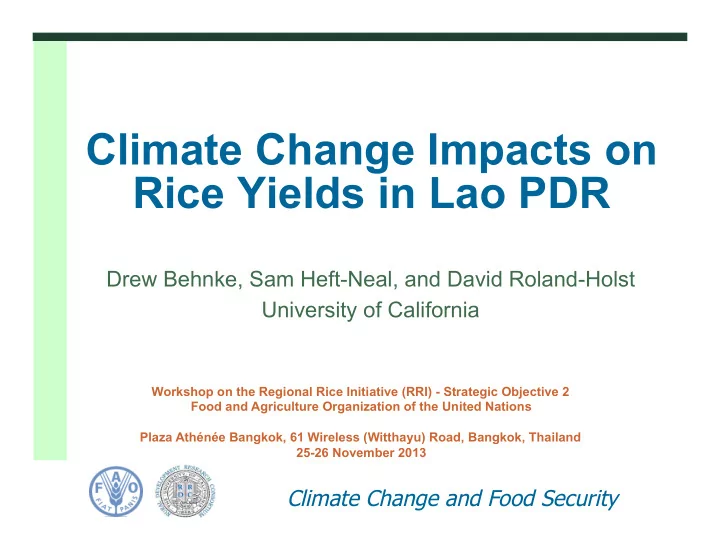

Climate Change Impacts on Rice Yields in Lao PDR Drew Behnke, Sam Heft-Neal, and David Roland-Holst University of California Workshop on the Regional Rice Initiative (RRI) - Strategic Objective 2 Food and Agriculture Organization of the United Nations Plaza Athénée Bangkok, 61 Wireless (Witthayu) Road, Bangkok, Thailand 25-26 November 2013 Climate Change and Food Security
Climate Risk: About Mean and Variance • Like sea level, the mean and variance of temperature are both rising: • Trend movement in climate variables will have the most lasting effects on patterns of food production, but • Stochastic variation is the greater and more immediate threat to local and national food security • Adaptation needs to be learned, but we already have a lot of experience with variance. • By improving early warning capacity, we can begin now to design and target appropriate interventions. Climate Change and Food Security Slide 2
Mean Wet-Season Weather Conditions Climate Change and Food Security Slide 3
Mean Decadal Changes in Seasonal Weather Conditions blue = 1970s, green = 1980s, purple = 1990s, orange = 2000s Climate Change and Food Security Slide 4
Population Affected by Major Flood and Drought Events in Lao PDR Climate Change and Food Security Slide 5
Average Rice Yields (t/ha), 2006-2012 Climate Change and Food Security Slide 6 Source: Crop Statistics Yearbook (DOA, Lao PDR)
Largest Rice Area Losses by Cause, 2006-2012 Source: Crop Statistics Yearbook (DOA, Lao PDR) Climate Change and Food Security Slide 7
Most Extreme Growing-Season Weather Conditions, 2006-2012 Source: Drought Severity Index (DSI) described in Mu et al (2013) Climate Change and Food Security Slide 8
Modeling Climate Risk to Rice Yields Maps of Forecast Yields Rainfall and Temperature Time Series Econometric Future of Forecast Drought/Flood Models of Climate Yields Intensity Yield Risk Scenarios Historical Yield Box-plots Data comparing 14 Global predictions Circulation across models Models, Downscaled to Lao PDR Climate Change and Food Security Slide 9
Data Resources Rainfall and Monthly gridded data Temperature Drought/Flood 8-day high resolution Intensity satellite data Lao PDR Department of Historical Yield Data Agriculture and IRRI Climate Change and Food Security Slide 10
Panel Models of Average Weather Effects and Shocks Equation 1: Trend Risk log(Y dt ) = γ d + θ t + β 1 MinT dt + β 2 MaxT dt + β 3 P + ε dt Y dt is yield for district d in year t. The model includes province fixed effects γ d and year fixed effects θ t . β 1-3 represent the coefficients on our weather variables Equation 2: Shock Risk Log(Y dt ) = γ d + θ t + β 1 Dr dt + β 2 X dt + ε dt β 1 represents the coefficients on our drought measure. X dt are other controls. Climate Change and Food Security Slide 11
Most Extreme Growing-Season Weather Conditions, 2006-2012 Drought Severity Index (DSI) The figure shows average area-weighted DSI values for Lao PDR districts. Blue represents greater than normal and red represents less than normal water levels. Climate Change and Food Security Slide 12
Forecast Lao PDR Climate Conditions: Averaged across 14 Global Circulation Models Climate Change and Food Security Slide 13
Projected Yield Changes Yields may actually increase in some upland (lower temperature) areas for two decades, then decline with national yields. Other provinces should be targeted for adaptation support according to emergent yield risk (red). Estimates are conservative (linear model). Climate Change and Food Security Slide 14
Yield Changes: A1B Scenario Thailand: Results of a non-linear model Climate Change and Food Security Slide 15
Preliminary Conclusions • Climate risk to the Lao PDR rice sector in will vary significantly over space and time. • This heterogeneity presents an opportunity, for policymakers and private stakeholders to learn adaptation. • To support this, we propose an early warning mechanism that can identify and target risks as they emerge. • Two generic risk categories need to be monitored: • Direct – risks to domestic food production • Indirect – risks to food security transmitted through markets Climate Change and Food Security Slide 16
Recommend
More recommend